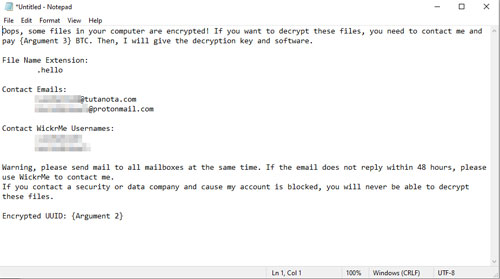Ransom.MSIL.HELLO.YALP-A
Trojan-Dropper.Win32.Delf {IKARUS}; Backdoor.Bladabindi {VBA32}
Windows


Threat Type: Ransomware
Destructiveness: No
Encrypted: Yes
In the wild: Yes
OVERVIEW
Downloaded from the Internet, Dropped by other malware
This Ransomware arrives on a system as a file dropped by other malware or as a file downloaded unknowingly by users when visiting malicious sites.
It drops files as ransom note.
TECHNICAL DETAILS
1,231,360 bytes
EXE
No
15 Dec 2020
Drops files, Disables services, , Encrypts files, Displays message/message boxes
Arrival Details
This Ransomware arrives on a system as a file dropped by other malware or as a file downloaded unknowingly by users when visiting malicious sites.
Installation
This Ransomware drops the following files:
- %public%\Desktop\list.hello → List of all encrypted files
- %Desktop%\list.hello → List of all encrypted files
- %All Users Profile%\Microsoft\Crypto\RSA\MachineKeys\{random GUID}
(Note: %Desktop% is the current user's desktop, which is usually C:\Documents and Settings\{User Name}\Desktop on Windows 2000(32-bit), XP, and Server 2003(32-bit), or C:\Users\{user name}\Desktop on Windows Vista, 7, 8, 8.1, 2008(64-bit), 2012(64-bit) and 10(64-bit).. %All Users Profile% is the common user's profile folder, which is usually C:\Documents and Settings\All Users on Windows 2000(32-bit), XP, and Server 2003(32-bit), or C:\ProgramData on Windows Vista, 7, 8, 8.1, 2008(64-bit), 2012(64-bit) and 10(64-bit). )
It adds the following processes:
- "%System%\vssadmin.exe" delete shadows /all → Deletes shadow copy
- "powershell.exe" Dismount-DiskImage "{Found filepath.vhd}" → Dismounts Virtual Drives
(Note: %System% is the Windows system folder, where it usually is C:\Windows\System32 on all Windows operating system versions.)
Process Termination
This Ransomware terminates the following services if found on the affected system:
- mssql
- sql
- postgresql
- oracle
- mysql
- veeam
- backup
Other Details
This Ransomware encrypts files with the following extensions:
- *.txt
- *.doc?
- *.xls?
- *.ppt?
- *.csv
- *.zip?
- *.rar?
- *.7z?
- *.gz?
- *.sql
- *.mdf
- *.myd
- *.ibd
- *_fsm
- *_vm
- *.db?
- *.rpt
It does the following:
- It deletes files with following extensions in their filenames:
- *.bak
- *.bk
- *.vbk
- *.vbm
- *.vhd
- It deletes files with following strings in their filenames:
- *backup*
- It requires a specific argument to proceed with its encryption routine.
Ransomware Routine
This Ransomware avoids encrypting files found in the following folders:
- %Windows%\
- %All Users Profile%\
- %System Root%\$recycle bin\
- %System Root%\Common Files\
- %System Root%\windowspowershell\
(Note: %Windows% is the Windows folder, where it usually is C:\Windows on all Windows operating system versions.. %All Users Profile% is the common user's profile folder, which is usually C:\Documents and Settings\All Users on Windows 2000(32-bit), XP, and Server 2003(32-bit), or C:\ProgramData on Windows Vista, 7, 8, 8.1, 2008(64-bit), 2012(64-bit) and 10(64-bit). . %System Root% is the Windows root folder, where it usually is C:\ on all Windows operating system versions.)
It appends the following extension to the file name of the encrypted files:
- .hello
It drops the following file(s) as ransom note:
- %public%\Desktop\Readme!!!.txt
- %Desktop%\Readme!!!.txt

SOLUTION
9.800
16.582.05
08 Mar 2021
16.583.00
09 Mar 2021
Step 1
Trend Micro Predictive Machine Learning detects and blocks malware at the first sign of its existence, before it executes on your system. When enabled, your Trend Micro product detects this malware under the following machine learning name:
- Troj.Win32.TRX.XXPE50FFF039
Step 2
Before doing any scans, Windows 7, Windows 8, Windows 8.1, and Windows 10 users must disable System Restore to allow full scanning of their computers.
Step 3
Note that not all files, folders, and registry keys and entries are installed on your computer during this malware's/spyware's/grayware's execution. This may be due to incomplete installation or other operating system conditions. If you do not find the same files/folders/registry information, please proceed to the next step.
Step 4
Search and delete this file
- %public%\Desktop\list.hello
- %Desktop%\list.hello
- %public%\Desktop\Readme!!!.txt
- %Desktop%\Readme!!!.txt
- %All Users Profile%\Microsoft\Crypto\RSA\MachineKeys\{random GUID}
Step 5
Scan your computer with your Trend Micro product to delete files detected as Ransom.MSIL.HELLO.YALP-A. If the detected files have already been cleaned, deleted, or quarantined by your Trend Micro product, no further step is required. You may opt to simply delete the quarantined files. Please check the following Trend Micro Support pages for more information:
Step 6
Restore encrypted files from backup.
Did this description help? Tell us how we did.

